

Society. Massai. Massai (also known as: Massa, Massi, Masai, Wasse or Massey; c.1847-1906,[1] 1911[2]) was a member of the Mimbres /Mimbreños local group of the Chihenne band of the Chiricahua Apache.
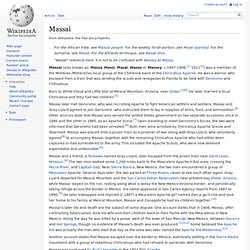
He was a warrior who escaped from a train that was sending the scouts and renegades to Florida to be held with Geronimo and Chihuahua. Born to White Cloud and Little Star at Mescal Mountain, Arizona, near Globe.[3][4] He later married a local Chiricahua and they had two children.[5] Massai later met Geronimo, who was recruiting Apache to fight American settlers and soldiers.
Another account states that Massai escaped over the border to Mexico, eventually settling in the Sierra Madre mountains with a group of rebellious Chiricahuas who had refused to surrender with Geronimo. See also[edit] References[edit] Tribal chief. A tribal chief is the leader of a tribal society or chiefdom.
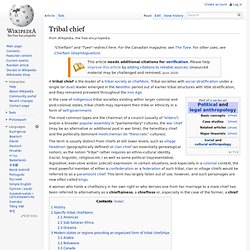
Tribal societies with social stratification under a single (or dual) leader emerged in the Neolithic period out of earlier tribal structures with little stratification, and they remained prevalent throughout the Iron Age. In the case of indigenous tribal societies existing within larger colonial and post-colonial states, tribal chiefs may represent their tribe or ethnicity in a form of self-government. The term is usually distinct from chiefs at still lower levels, such as village headman (geographically defined) or clan chief (an essentially genealogical notion), as the notion "tribal" rather requires an ethno-cultural identity (racial, linguistic, religious etc.) as well as some political (representative, legislative, executive and/or judicial) expression.
History[edit] Sahara. The top image shows the Safsaf Oasis on the surface of the Sahara.
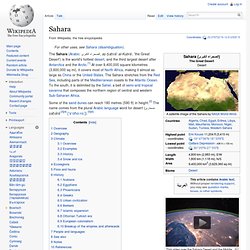
The bottom (using radar) is the rock layer underneath, revealing black channels cut by the meandering of an ancient river that once fed the oasis. Kalahari Desert. Kalahari in Namibia The Kalahari Desert (in Afrikaans Kalahari-woestyn) is a large semi-arid sandy savannah in southern Africa extending 900,000 square kilometres (350,000 sq mi), covering much of Botswana and parts of Namibia and South Africa.
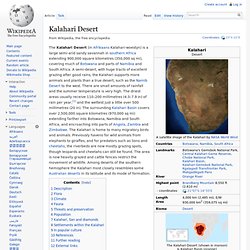
A semi-desert, with huge tracts of excellent grazing after good rains, the Kalahari supports more animals and plants than a true desert, such as the Namib Desert to the west. There are small amounts of rainfall and the summer temperature is very high. The driest areas usually receive 110–200 millimetres (4.3–7.9 in) of rain per year,[1] and the wettest just a little over 500 millimetres (20 in). Kalahari Desert could dust up Southern Ocean. Take a deep breath.

If you live in the northern hemisphere then you will have inhaled a fair amount of dust. If you live in the southern hemisphere that breath was relatively dust free. However, new research indicates that the southern hemisphere is set to become dustier, as the South-African Kalahari Desert starts to erode. Ultimately, this additional airborne sand may breathe new life into ocean ecosystems. Meroë. Meroë is northeast of Khartoum (center right).

Coordinates: Meroë /ˈmɛroʊeɪ/ (also spelled Meroe[1][2]) (Meroitic: Medewi or Bedewi; Arabic: مرواه Meruwah and مروى Meruwi, Ancient Greek: Μερόη, Meróē) is an ancient city on the east bank of the Nile about 6 km north-east of the Kabushiya station near Shendi, Sudan, approximately 200 km north-east of Khartoum. Animism. Specifically, animism is used in the anthropology of religion as a term for the belief system or cosmology of some indigenous tribal peoples,[5] especially prior to the development and/or infiltration of colonialism and organized religion.[6] Although each culture has its own different mythologies and rituals, "animism" is said to describe the most common, foundational thread of indigenous peoples' "spiritual" or "supernatural" perspectives.
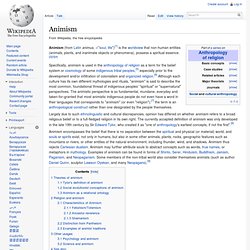
The animistic perspective is so fundamental, mundane, everyday and taken-for-granted that most animistic indigenous people do not even have a word in their languages that corresponds to "animism" (or even "religion");[7] the term is an anthropological construct rather than one designated by the people themselves. Largely due to such ethnolinguistic and cultural discrepancies, opinion has differed on whether animism refers to a broad religious belief or to a full-fledged religion in its own right. Griot. Senegalese Wolof griot, 1890 A griot (/ˈɡri.oʊ/; French pronunciation: [ɡʁi.o]), jali or jeli (djeli or djéli in French spelling) is a West African historian, storyteller, praise singer, poet and/or musician.

The griot is a repository of oral tradition, and is also often seen as something of a societal leader due to his traditional position as an adviser to royal personages. As a result of the former of these two functions, he is sometimes also called a bard. According to Paul Oliver in his book Savannah Syncopators, "Though [the griot] has to know many traditional songs without error, he must also have the ability to extemporize on current events, chance incidents and the passing scene. His wit can be devastating and his knowledge of local history formidable".